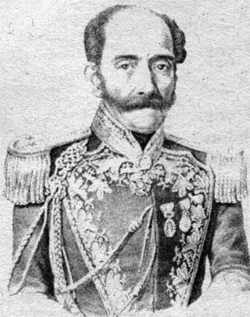- Juan Gregorio de las Heras
Infobox Person
name=Juan Gregorio de las Heras
caption=
birth_date=birth date|1780|7|11|mf=y
dead=dead
birth_place=Buenos Aires ,Argentina
death_date=death date and age|1866|2|15|1780|7|11|mf=y
death_place=Santiago,Chile Grand Marshal Juan Gregorio de las Heras (July 11 ,1780 –February 15 ,1866 ) was an Argentine soldier who took part in theSouth American Wars of Independence and was also a governor of the province of Buenos Aires.De las Heras was born in Buenos Aires, from a moderately wealthy family. He engaged in business till the age of twenty-six, when he enlisted in the army, taking part in the resistance against the
British invasions of the Río de la Plata (1806–1807). In 1808 he became sergeant of hussars, and, when independence was declared in 1810, he acted with the patriots, was appointed captain of militia in Cordoba, and in 1812 became commander of the garrison of that city. In 1813 he offered to accompany the auxiliary Argentine division sent toChile , of which he became second in command. After theBattle of Cucha-Cucha he attained the rank of colonel, and after the defeat of Rancagua (2 October 1814), he retired in good order and twice repulsed the enemy, returning to Mendoza, where he employed himself in the organization of theArmy of the Andes .On November 8th, he was appointed as the first commander of the newly created 11th Line Infantry Regiment. Created at the proposal of General San Martín to the Government, during the organization of the Army of the Andes and using the Chilean Auxiliaries as the foundation. This was the same infantry corps that had been sent to Chile in 1812, commanded by then Lieutenant Colonel de Las Heras to assist the Government Junta to face the invasion of the Royalists in the South of Chile. The Auxiliaries received their baptism of fire in the battle of Cucha-Cucha on February 23, 1814, and fought successfully for a second time in Membrillar on May 20. After the important Spanish victory in Rancagua in October, they were charged with covering the retreat of their Chilean comrades and their government to the city of Mendoza. In 1815, the 11th Line had the first regimental band of the Army of the Andes, thanks to the economic support of Don Rafael Vargas, a rancher from Mendoza. When the Army moved to Chile in 1817, the regiment crossed the mountain range using the Uspallata pass, always commanded by Las Heras. After contributing to winning the battle of Chacabuco, he headed the South Division, that was involved in a night battle on April 4 in Curapaligüe and on May 5 in Gavilán, two resounding victories. It also took part in the failed assault on Talcahuano, December 6. On April 5, 1818, the 11th Line fought heroically in the Battle of Maipu, which sealed the freedom of Chile. It was created once again in 1885 and sent to hold positions in the frontier of the territories occupied by wild Indians, such as Tapalqué, Olavarria and Tres Arroyos, in the Province of Buenos Aires. In 1910 the President of Argentina Dr. José Figueroa Alcorta issue a decree to rename it 11th Infantry Regiment "General Las Heras" in honor of its first commander. Currently, the 11th Mountain Infantry Regiment is headquartered in Tupungato, Province of Mendoza.
In 1817, de las Heras took charge of a part of the
Army of the Andes , replacingAntonio González de Balcarce . Leading one column by the pass ofUspallata , he commanded in the battles of Potrerillos, Guardia, and Villa de los Andes. Together with the forces of General San Martin he took part in theBattle of Chacabuco , (12 February 1817), and immediately afterward was sent to the south, where he gained the victories of Curapalihue, Vegas de Talcahuano, and Oavihm, and was present at both of the sieges of Talcahuano under the orders of GeneralBernardo O'Higgins .He also participated in the liberating expedition to
Peru . Transported by sea, the Regiment disembarked in Peru in September 1820, where it was involved in the battles of Nazca, Acarí and Jauja and in the siege and occupation of Lima on July 9, 1821, as well as in the surrender of the fort of El Callao on September 21. In 1824 the 11th Line was disbanded. In 1820 he was chief of staff of the liberating army of Peru, and in the same year was promoted to brigadier by the Argentine government, and general of division by the Chilean government. In Peru he had the command of the siege of the castles of Callao and received the title of Grand Marshal.After his retirement from the Army in Peru, he went back to the Argentine Republic, where De las Heras was appointed governor of Buenos Aires by the Chamber of Representatives, succeeding General
Martín Rodríguez in May, 1824. During his government the congress of theUnited Provinces of the Río de la Plata met on 16 December, 1824, and De las Heras signed a treaty with the Britain acknowledging their independence.On the restoration of the confederation and the election of
Bernardino Rivadavia to the executive, De las Heras delivered the government to him onMarch 7 ,1825 , and in 1826 he returned to Chile. He was deprived of his rank on account of his participation in theChilean Civil War of 1829 , but the rank was restored by the Chilean Congress in 1842 and by the Argentine congress in 1855. From 1862 till the time of his death he was inspector-general of theChilean Army . De las Heras died in Santiago in 1866, at the age of 85.
Wikimedia Foundation. 2010.
